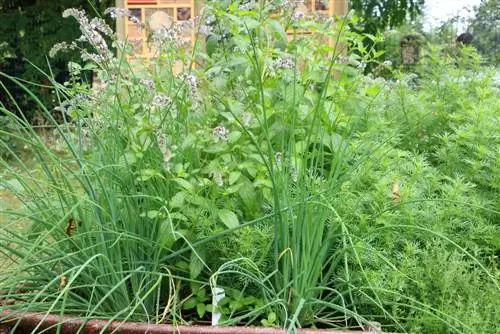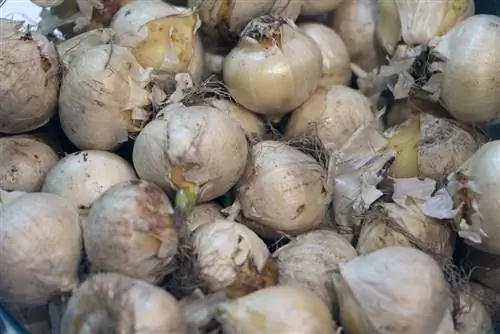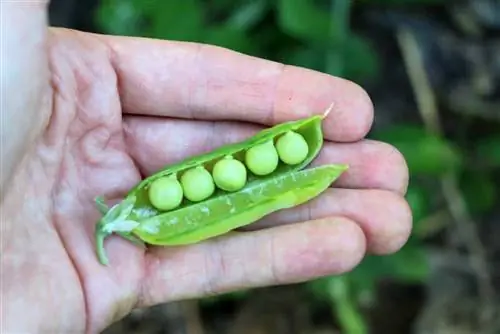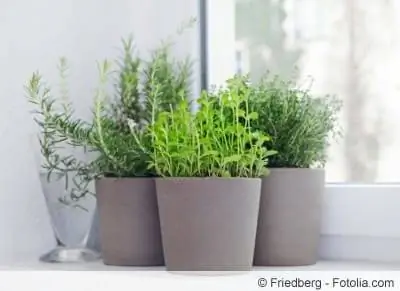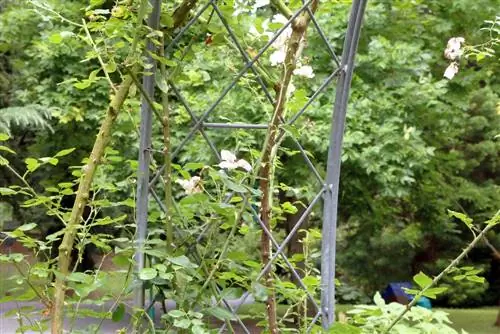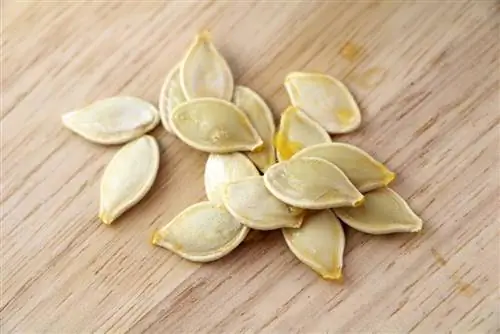- Author admin [email protected].
- Public 2023-12-17 03:39.
- Last modified 2025-01-24 12:45.
Chives are not just a plant for the garden bed, the leek can also be easily cultivated in pots in the home. The prerequisite for this is enough air and light. Anyone who only knows the small pots from the supermarket thinks that chives cannot be cultivated this way because they quickly turn yellow. But what many people don't know is that these pots were designed for immediate, fresh consumption. But Allium schoenoprasum is not an annual and with proper care can live a long time and be harvested regularly.
Location
The ideal location for chives in the home is light and airy. Therefore, a bright windowsill where the window can be opened in summer is best suited here. As a rule, the herb should be in the kitchen because it is also used here. If there is no window sill here, the space can also be designed differently:
- on a table under the window in a bright corner
- A small herb garden can be created here
- on countertop near window
- Place the pot hanging from the ceiling in front of the window
- For attic apartments, attach the pot outside to the roof
- look for a place that can be easily reached from the window
- if the window seat in the kitchen is too dark, look for an alternative
- Window sill in the stairwell
- Window sill in the dining room
- if available, on the balcony or terrace in summer
Tip:
Allium schoenoprasum should never be planted in a pot or bowl with other herbs. The leek should always be given its own pot, which can then find a decorative place together with other potted herbs.
Substrate & Soil
Poting soil, pot soil or herb soil for the pot in which it is cultivated are suitable for the substrate. This already provides the permeability that the leek plant desires. The ideal earth looks like this:
- nutrient-rich
- slightly moist
- alternatively mix garden soil with clay powder or sand
Sowing
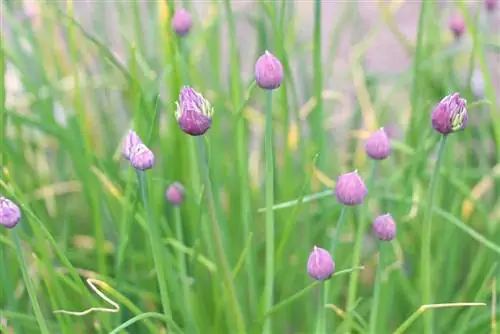
Potting soil is required for sowing, because the commercially available potting soil has too few nutrients for the seeds of the leek plant. Chives are both cold germinators and dark germinators. The seeds are sown directly in the container that was selected for cultivation. Since the leek does not tolerate any waterlogging, the pot must be created with drainage before filling in the soil and sowing. To do this, small pebbles are spread over the drainage holes and a plant fleece is placed over them. This prevents soil from getting between the stones with the irrigation water and blocking the drain. Once the pot has been prepared, proceed with sowing as follows:
- Chives can be sown indoors at any time of the year
- put the commercial seeds into the ground
- distribute well in the pot, do not put them too close together
- cover with soil
- water well and keep moist
- a transparent film is helpfully pulled over the pot
- ventilate well every day
- do not place the pot in direct sun
- since they are cold germs, don't keep them too warm
- the warmer it is, the longer germination takes
A germination temperature between 5° and 10° Celsius is ideal. If a bright garage or a bright, cool basement room is available, this is the ideal location until the first seedlings appear.
Tip:
If too many seeds are put into one pot, the future plants could suffocate. Therefore, only a few seeds are sufficient per pot, and they should not be too close together. Because Allium schoenoprasum needs a lot of air and space, including between the stalks of the individual plants.
Plants
The small pots of chives available in the supermarket are usually intended for immediate use and therefore do not last long on the windowsill. However, immediate measures can be taken to ensure that these chives also grow and thrive. The pot in which the chive plants are sold in the supermarket is usually too small and the soil is often dry and devoid of nutrients. If such a plant is to be cultivated in the apartment for a longer period of time, you should proceed as follows:
- choose a larger container
- Create drainage
- Fill half of the potting soil with enough nutrients
- water the chive pot well
- take the whole thing out of the pot
- carefully remove the old soil as best you can
- insert into new container
- fill up the remaining soil and press it down well
- water well
- after half an hour, pour excess water from the plate
Tip:
In this way, the chives from the supermarket can also reach a ripe old age. However, if it is left in the pot provided, it will turn yellow after a while and will not produce new or stunted leek stems.
Pouring
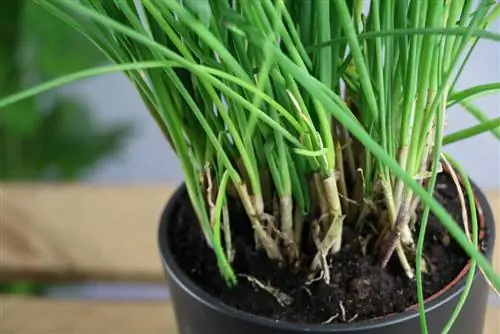
The advantage of Allium schoenoprasum is that it tolerates lime very well. Therefore, it can easily be watered with tap water, which always contains a portion of lime, depending on the community. The leek plant likes it moist, so it needs to be watered regularly and care must be taken to ensure that the soil does not dry out. If this happens, it not only damages the leek stalks, which then turn yellow and dry, but also the roots. Chives that have been exposed to dry soil for a long time usually do not recover. During the casting process, attention should be paid to the following:
- when the top soil dries out, water
- always from below to the roots
- do not pour over the leek
- Avoid waterlogging
- avoid drying out
- do not water in full sunlight
Fertilize
Chives should be fertilized regularly every two to three weeks. For this purpose, liquid fertilizer can be added to the irrigation water according to the instructions on the package. Ideally, an organically based fertilizer should always be used for herbs and leek plants, as they are a plant that is consumed. Chemical-based fertilizers can change the taste and are not ideal for the human body if consumed frequently through the fertilized plant.
Cutting
Allium schoenoprasum is usually not cut, but is cut through the harvest. The leek plant can be harvested whenever needed throughout the year. This means that a rejuvenation cut is not necessary, as is often the case with other herbs. If it is a young chive plant, it should hardly be cut so that it can grow better. However, a small harvest is usually possible after six weeks after sowing. The plant, on the other hand, is thinned out when it is harvested, even if only individual stalks are needed in the kitchen, they can be cut fresh every day. The procedure is as follows:
- Cut the stalks about two to three centimeters above the ground
- always cut the outer stalks
- the new shoots are formed inside
- prune in time before flowering
- Stalks that bloom don't taste good
- only leave flowers if seeds are to be harvested
- Flowers are also decorative and even edible
- use clean and sharp scissors for cutting
Tip:
If the individual regrowing stalks form brown spots at the tips, then this has no meaning. This is the injury that was caused to the stalk when it was cut before it grew back large. These brown spots can easily be removed before consumption.
Propagate
Chives can be propagated by division. However, this is not only useful for preserving additional plants, but also an important part of care. As a rule, the leek should be divided every three years, because if it is not reduced regularly, the stalks have too little space and air and then grow fewer and finer. When dividing, you should proceed as follows:
- not during winter rest
- otherwise, division of potted plants can be done at any time
- take all the leeks out of the pot
- divide the root ball with a sharp, clean knife
- plant all parts individually in other pots
Tip:
Since chives should be harvested regularly, otherwise the stalks turn yellow and die, many chive plants can sometimes have a surplus in the harvest. However, the stalks can be cut into small pieces and frozen in portions
Wintering
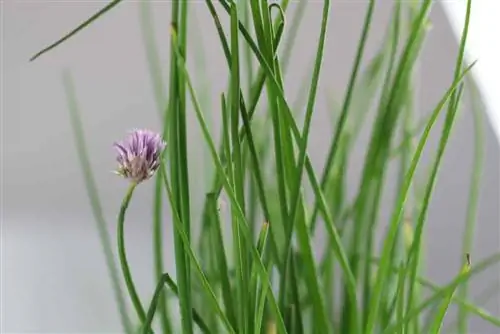
So that the plant lives for a long time and grows very old, Allium schoenoprasum must also be cultivated indoors and prepared for the winter. The leek plant is hardy and should not be kept indoors over the winter when temperatures remain constant. So it is better if it is given a few weeks of winter rest in a cooler place so that it can sprout again quickly next year. Therefore, the winter rest period for the chives should look like this:
- Cut the chives completely
- Use the straws in the kitchen or freeze them chopped into small pieces
- then place the pot in a bright, cool room for about two months
- Pot can also overwinter outside, then it should be covered with mulch
- otherwise an unheated winter garden is ideal
- A window sill in a stairwell can also serve as a winter rest facility
- don't let it dry out
- but don’t water too much
- stop fertilizing during winter rest
- return to original location after the rest period
Tip:
With the right care, the chives, which are around 50 cm high, can live up to 20 years or more without having to change their location. This means that chives don't have to be sown again every year.
Care errors & illnesses
A big problem that can occur with chives is dry and yellow leaves. These multiply very quickly, but are absolutely not suitable for use in the kitchen. Therefore, action must be taken immediately at the first signs of yellowing. This can be due to the following different reasons:
- Chives are too dry or too hot
- for example behind a window pane with long exposure to sunlight
- then change location or water more often
- Chives are too wet
- root rot occurs
- then remove the plant from the soil
- cut off all damaged roots
- water less afterwards
Tip:
For plants cultivated indoors, fungal diseases that affect the plants due to summers that are too humid generally do not occur.
Pests
Chives are actually planted in garden beds to combat various pests. However, it can also be attacked by aphids itself, especially if it was cultivated on the windowsill in the apartment. The chive plants in pots are less robust than those planted in the garden bed. In addition, the pests often have no other alternative and for this reason they settle on the chives. To keep the stalks edible, they should be sprayed with nettle broth. Due to consumption, commercial insecticides are not a good choice.
Conclusion
Chives are a very undemanding plant that only need regular fertilizer and water. If it is kept bright and warm, it can be cultivated in the apartment all year round and harvested regularly. In addition, flowering Allium schoenoprasum is also pretty to look at, the flowers are also edible and are often used in a salad in modern kitchens. Only in winter should the plant be given a short rest period, during which it is not fertilized and watered very sparingly. Afterwards, the chives sprout again even more beautifully. A single plant can live up to 20 years or more because it continues to grow back even after a large harvest.

